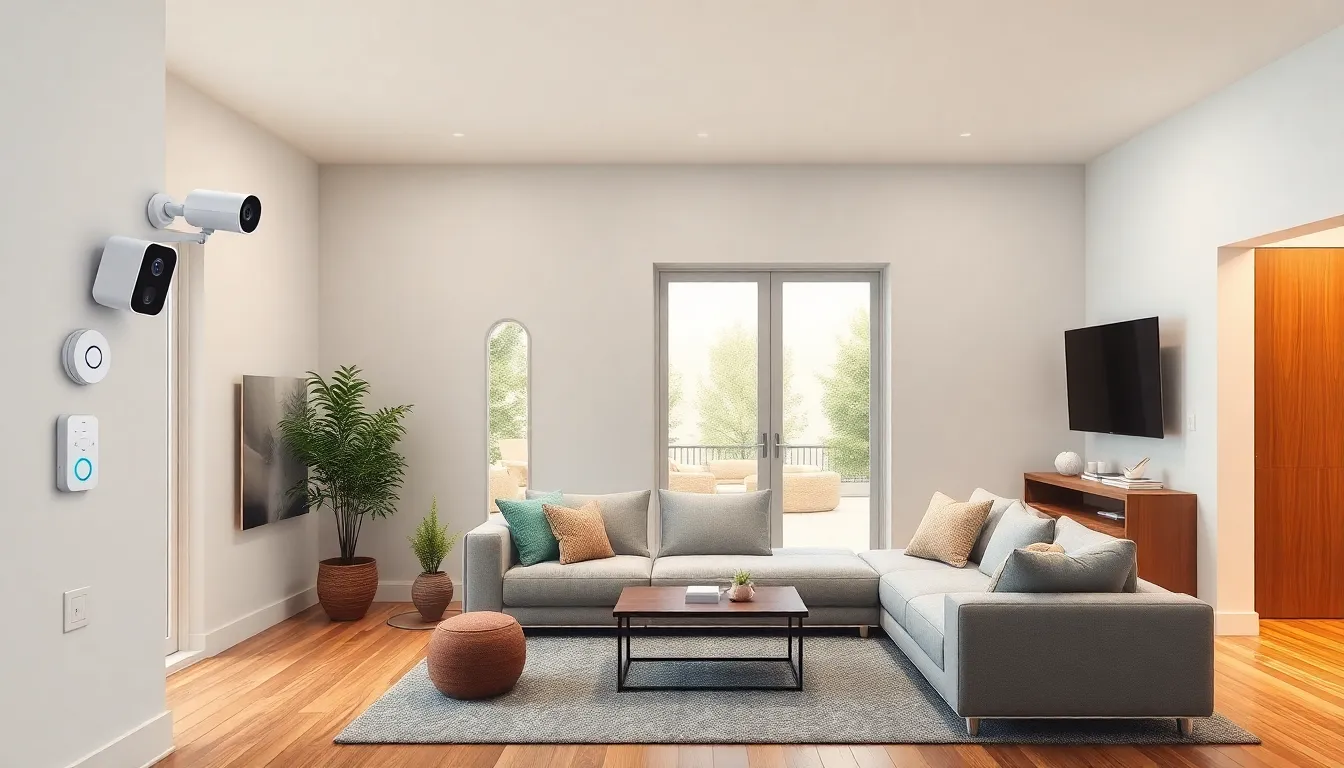In a world where your refrigerator can remind you to buy milk and your thermostat knows when you’re too hot to handle, home security has entered the digital age. The Internet of Things (IoT) is revolutionizing how we protect our homes, making it easier and smarter than ever. Imagine a home that not only locks its doors but also sends you a cheeky text when it catches an intruder trying to sneak in for a midnight snack.
With IoT home security, gone are the days of clunky alarm systems and forgetting to set the lock before bed. Now, you can monitor your castle from anywhere, all while enjoying the peace of mind that comes with knowing your home is as secure as a fortress—complete with a moat of smart technology. Let’s dive into the world of IoT home security and explore how it’s changing the game for homeowners everywhere.
Table of Contents
ToggleOverview of Internet of Things Home Security
Internet of Things home security revolutionizes traditional security measures by integrating smart devices. This combination allows homeowners to control security systems through smartphones, making monitoring easy from any location. Devices such as smart cameras, doorbell cameras, and motion sensors enhance home safety with real-time alerts.
Connected devices communicate with each other, increasing the effectiveness of security protocols. For instance, when a motion sensor detects activity, it can automatically activate cameras and send notifications to homeowners. This interconnectedness streamlines responses to potential threats.
Remote monitoring offers significant advantages. Homeowners can check feeds from their devices while away, providing peace of mind. Alerts for suspicious activities help users make informed decisions swiftly.
Data-driven insights improve the functionality of IoT security systems. By analyzing patterns, smart systems can distinguish between ordinary movement and unusual activity. They reduce false alarms and enhance overall security measures.
Integration with voice assistants simplifies commands. Users can easily request status updates, arm systems, or disable alarms through simple voice commands. This hands-free access adds convenience for busy homeowners.
Regular software updates keep devices secure. Manufacturers prioritize security patches to fix vulnerabilities, ensuring protection against evolving cyber threats. Consequently, homeowners can rely on continuous improvements in their systems.
Overall, IoT home security solutions provide advanced features that traditional systems lacked. With greater convenience, better monitoring, and improved response times, modern security helps protect homes more effectively.
Key Components of IoT Home Security

IoT home security comprises several key components that enhance safety and convenience. These elements work together to create a robust security system, providing peace of mind for homeowners.
Smart Cameras
Smart cameras play a crucial role in enhancing security. They deliver real-time video feeds directly to smartphones. Users can monitor their properties from anywhere, ensuring immediate awareness of any activity. Features like night vision and motion detection improve functionality and reliability. Many smart cameras also include cloud storage for easy access to recorded footage. Integration with mobile apps allows for quick control and customizable settings. Overall, smart cameras are vital for effective surveillance and threat detection.
Smart Doorbells
Smart doorbells add an extra layer of protection. With built-in cameras and two-way audio, they enable users to see and communicate with visitors remotely. Personalized alerts notify homeowners when someone approaches. Many models offer package detection and alerts for deliveries, minimizing theft risk. The convenience of real-time notifications helps users decide whether to engage with visitors. Smart doorbells also enhance overall home security by acting as a deterrent to potential intruders.
Sensors and Alarms
Sensors and alarms are foundational elements of IoT home security systems. They detect various activities and provide immediate alerts, enhancing safety. Motion sensors identify movements and send notifications, ensuring homeowners remain informed. Smoke detectors and carbon monoxide alarms protect against environmental hazards, adding comprehensive coverage. Integration with other smart devices allows for coordinated security responses. Overall, these components provide essential protection, reinforcing the effectiveness of IoT home security systems.
Benefits of Internet of Things Home Security
Internet of Things (IoT) home security provides numerous advantages, transforming the way homeowners protect their properties. Enhanced features significantly improve safety and convenience.
Increased Convenience
Smart home security systems streamline management through integration with mobile devices. Homeowners access various functionalities on their smartphones, from locking doors to adjusting camera angles. Cloud-based storage ensures footage is readily available, reducing the need for on-site recording devices. User-friendly interfaces simplify the operation of multiple devices, enhancing usability. Voice control compatibility enables effortless command execution, eliminating the need for physical interaction. Effortless automation allows for customized settings, adapting to the homeowner’s schedule.
Remote Monitoring
IoT home security allows for comprehensive remote monitoring at any time. Users view live camera feeds from anywhere with internet access, providing reassurance during vacations or long workdays. Multiple camera angles deliver a complete overview of property spaces, increasing situational awareness. The ability to check on pets or receive delivery notifications contributes to peace of mind. Furthermore, integration with smart devices facilitates seamless system status updates. Effective remote control options empower homeowners to manage their security systems proactively.
Real-time Alerts
Immediate alerts enhance the effectiveness of IoT home security systems, keeping homeowners informed about potential threats. Notifications regarding motion detection, door opening, or unexpected disturbances arrive instantaneously. Users customize alert settings, ensuring they receive only the information they deem essential. This proactive communication allows for swift action in response to abnormal activities. Integration with emergency services streamlines reporting processes, expediting responses to security incidents. Enhanced safety results from these timely updates, promoting quick decision-making for households.
Challenges and Considerations
IoT home security systems present unique challenges and considerations that users must address. Understanding these elements ensures effective implementation and optimal security.
Security Risks
Cybersecurity threats pose significant risks to IoT home security systems. Hackers can exploit vulnerabilities in devices, gaining unauthorized access to confidential data or home networks. Regular updates are essential for patching security flaws. Data encryption protects sensitive information by making it unreadable to unauthorized users. Additionally, users must choose strong, unique passwords for devices and network access to further mitigate risks. Another critical aspect involves the potential for device malfunctions, which could compromise overall security.
Installation and Maintenance
Proper installation determines the effectiveness of IoT home security systems. Users should follow manufacturer’s guidelines for setup and ensure optimal placement of devices for maximum coverage. Ongoing maintenance is equally crucial in maintaining security integrity. Regularly checking device functionality ensures all components work together seamlessly. Users must invest time in managing software updates, as these often include vital security enhancements. Involvement with professional installers may provide additional support, particularly for complex systems, and ensure a more secure setup.
Embracing IoT home security systems represents a significant advancement in protecting households. With smart devices providing real-time monitoring and alerts homeowners can enjoy increased peace of mind. The integration of various components like smart cameras and doorbell systems enhances safety and convenience.
While the benefits are substantial the importance of cybersecurity cannot be overlooked. Homeowners must remain vigilant about updates and proper installation to safeguard their systems. By understanding both the advantages and challenges of IoT home security individuals can make informed decisions that lead to a safer living environment. Investing in these technologies not only enhances security but also contributes to a smarter home experience.




